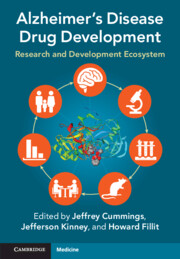Book contents
- Alzheimer’s Disease Drug Development
- Alzheimer’s Disease Drug Development
- Copyright page
- Dedication
- Contents
- Contributors
- Foreword
- Acknowledgments
- Section 1 Advancing Alzheimer’s Disease Therapies in a Collaborative Science Ecosystem
- 1 Alzheimer’s Disease Drug Development: A Research and Development Ecosystem
- 2 Drug Development for Alzheimer’s Disease: An Historical Perspective
- 3 Alzheimer’s Disease Drug Discovery in Academia: From High-Throughput Screening to In Vivo Testing
- 4 The Harrington Discovery Institute and Alzheimer’s Disease Drug Development
- 5 Repurposed Agents in Alzheimer’s Disease Drug Development
- 6 Artificial Intelligence in Alzheimer’s Drug Discovery
- Section 2 Non-clinical Assessment of Alzheimer’s Disease Candidate Drugs
- Section 3 Alzheimer’s Disease Clinical Trials
- Section 4 Imaging and Biomarker Development in Alzheimer’s Disease Drug Discovery
- Section 5 Academic Drug-Development Programs
- Section 6 Public–Private Partnerships in Alzheimer’s Disease Drug Development
- Section 7 Funding and Financing Alzheimer’s Disease Drug Development
- Index
- References
1 - Alzheimer’s Disease Drug Development: A Research and Development Ecosystem
from Section 1 - Advancing Alzheimer’s Disease Therapies in a Collaborative Science Ecosystem
Published online by Cambridge University Press: 03 March 2022
- Alzheimer’s Disease Drug Development
- Alzheimer’s Disease Drug Development
- Copyright page
- Dedication
- Contents
- Contributors
- Foreword
- Acknowledgments
- Section 1 Advancing Alzheimer’s Disease Therapies in a Collaborative Science Ecosystem
- 1 Alzheimer’s Disease Drug Development: A Research and Development Ecosystem
- 2 Drug Development for Alzheimer’s Disease: An Historical Perspective
- 3 Alzheimer’s Disease Drug Discovery in Academia: From High-Throughput Screening to In Vivo Testing
- 4 The Harrington Discovery Institute and Alzheimer’s Disease Drug Development
- 5 Repurposed Agents in Alzheimer’s Disease Drug Development
- 6 Artificial Intelligence in Alzheimer’s Drug Discovery
- Section 2 Non-clinical Assessment of Alzheimer’s Disease Candidate Drugs
- Section 3 Alzheimer’s Disease Clinical Trials
- Section 4 Imaging and Biomarker Development in Alzheimer’s Disease Drug Discovery
- Section 5 Academic Drug-Development Programs
- Section 6 Public–Private Partnerships in Alzheimer’s Disease Drug Development
- Section 7 Funding and Financing Alzheimer’s Disease Drug Development
- Index
- References
Summary
Alzheimer’s disease (AD) drug development is a complex process that proceeds from identification of a biological target; to testing of candidate therapies in in vitro assays; assessment of efficacy in animal models and assessment of safety in several animal species; clinical testing in humans in Phase1, Phase 2, and Phase 3 clinical trials; regulatory review by agencies in all countries in which the drug might be marketed; and eventual commercialization. This process requires more than a decade to accomplish. The process involves substantial infrastructure resources; multiple stakeholders; and funding from a variety sources along the developmental pathway. This is the complex ecosystem that supports AD drug development.
Keywords
- Type
- Chapter
- Information
- Alzheimer's Disease Drug DevelopmentResearch and Development Ecosystem, pp. 1 - 24Publisher: Cambridge University PressPrint publication year: 2022
References
- 3
- Cited by

